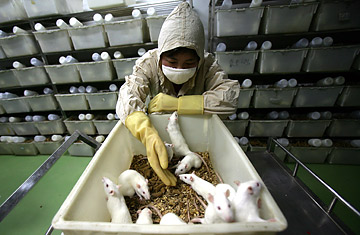
Not a week goes by without news of a lab breakthrough using rats or mice. But of all the promising medical interventions that make it to animal trials, only a fraction seem to translate into major breakthroughs for humans. Frankie Trull, president of the non-profit Foundation for Biomedical Research , explains the promise and the pitfalls of pre-clinical trials.
Q: What do animal trials really tell us about humans?
A: Animals are surrogates for humans. The basic reason for animal trials is to determine two issues before any new compound is introduced into a human: safety and efficacy, whether a compound is safe for human ingestion and also whether or not a product works for its intended purpose. Really that process begins way before we get to animals. But at some point in the process it is critical to understand how a compound, let’s say, a hypertension medication, works in a whole living system. You can’t just determine how it works on blood pressure or the heart. You need to know how it would affect all the organs. That really is the whole purpose of using a complex biological system known as an animal.
There is no question that, despite the excellent results that come out of lots of preclinical trials, the human is the ultimate animal model — and sometimes a potential downside to a new compound is not identified until it gets to a human. We often hear you can’t give aspirin to cats because it’s toxic to them, or you shouldn’t give chocolate to dogs. Chocolate, which is very safe in humans, is not safe in dogs. But when you go back and look at how many compounds fail before they ever get to humans, [it’s clear] animals do play a really important role in at least giving early signals — and it’s a constantly evolving science.
Over the past 60 years, scientists have figured out what works best in what models. The vast majority of animal testing [today] is in rodents, either rats or mice. Rodents, particularly mice, have very short life spans, so you can see how a compound would react in a young animal, then in the same geriatric animal, and then in the next-generation animal, all in a time frame that is reasonable. Then if a product or a compound is determined to be safe in a rodent, another species is used. For example, if it’s a neurological compound, oftentimes the cat is the preferred model because the neurological system of the cat more closely mimics that of a human. If it’s a cardiovascular study, it might be a dog . Scientists really do try to go that extra mile to find the species that will most accurately mimic how the compound would work in a human. We’re focusing right now in one of our programs on the horse. It has very similar osteoarthritis conditions to humans, but it shows them in a much more compressed period of time. Many, many species [are used in trials].
Of course, science is always making progress. You read a lot about these very special rodents, animals we call “transgenic animals.” [That means] if you’re studying diabetes, the mice have diabetes, so you can go right to specific disease targets in a much more expeditious way that you could in the old days. In the old days you just hoped they got diabetes. Also, as the scientific community is understanding more and more about the genome, whether it’s the human genome or the fruit fly genome, they’re better able to identify gene markers, to target them and start developing compounds that point to those specific diseases.
Increasingly scientists are also looking at non-animal models to provide more and more answers. That’s not only going to decrease the number of animals used in certain experiments but, more important for many, speed up the [drug approval] process. It’s everybody’s hope [that one day we could replace animal trials entirely with computer modeling]. But I don’t think it’ll happen during my lifetime. People in the research community will be the first to tell you they still don’t know enough about how the complex living organism works in order to duplicate it. Animals are not perfect. They’re definitely not a perfect mimic of a human, but they’re [still] as close as we’re going to get without using a human.